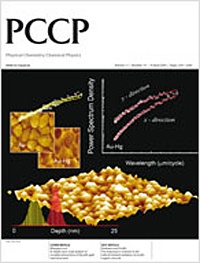May 27 2009
RMIT University researchers have used breakthrough nanotechnology to create a pioneering sensor that can precisely measure one of the world's most poisonous substances, mercury.
 RMIT’s research on mercury monitoring through nano-engineered gold surfaces recently featured on the cover of the prestigious journal, Physical Chemistry and Chemical Physics, a publication of the Royal Society of Chemistry. The research team behind the publication was led by Professor Suresh Bhargava and included Dr Prashant Sawant, Dr Vipul Bansal, Dr Samuel Ippolito and Dr Ylias Sabri
RMIT’s research on mercury monitoring through nano-engineered gold surfaces recently featured on the cover of the prestigious journal, Physical Chemistry and Chemical Physics, a publication of the Royal Society of Chemistry. The research team behind the publication was led by Professor Suresh Bhargava and included Dr Prashant Sawant, Dr Vipul Bansal, Dr Samuel Ippolito and Dr Ylias Sabri
The mercury sensor developed by RMIT's Industrial Chemistry Group uses tiny flecks of gold that are nano-engineered to make them irresistible to mercury molecules.
In the effort to reduce mercury contamination in the environment and the associated health risks, accurately measuring the toxin has become a priority for mercury-emitting industries like coal-burning power generators and alumina refineries.
Professor Suresh Bhargava, Dean of the School of Applied Sciences, said traditional mercury sensors used by industry could be unreliable.
"Industrial chimneys release a complex concoction of volatile organic compounds, ammonia and water vapour that can interfere with the monitoring systems of mercury sensors," Professor Bhargava said.
"We wanted a sensor that would be robust enough to cope with that kind of industrial environment but also sensitive enough to give precise readings of the amount of mercury vapour in these emissions."
The mercury sensor was developed with the use of patented electrochemical processes that enabled the RMIT researchers to alter the surface of the gold, forming hundreds of tiny nano-spikes, each one about 1,000 times smaller than the width of a human hair.
These nano-engineered surfaces are then used with existing technologies such as Quartz Crystal Microbalances - a finely tuned set of scales that measure weight down to molecular levels - to determine the levels of mercury in the atmosphere.
"We've known since ancient times that gold attracts mercury, and vice versa, but a regular gold surface doesn't absorb much vapour and any measurements it makes are inconsistent," Professor Bhargava said.
"Our nano-engineered gold surfaces are 180 per cent more sensitive than non-modified surfaces.
"They're finely targeted, so they're unaffected by the usual gases found in effluent gas streams.
"And the sensors we've created using those nano-engineered surfaces have worked successfully at a range of extreme temperatures over many months, just as they'll need to in an industrial location."
Funded through an Australian Research Council Linkage grant, the project was supported by leading industry partners, who have now engaged RMIT to develop a mercury sensing device for a pilot plant trial at one of their Australian refineries.
The Industrial Chemistry Group's multi-disciplinary team is one of Australia's leading research units working on solutions for the monitoring and clean-up of gas and liquid mercury.
The group will extend its work on mercury removal technology through an international collaboration with the Indian Institute of Chemical Technology at Hyderabad, focusing on putting the nano-engineered gold surfaces to use in a system that can absorb and remove mercury vapour from the air.